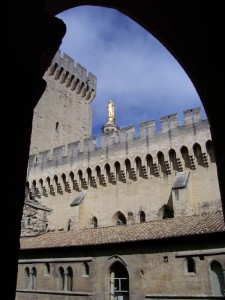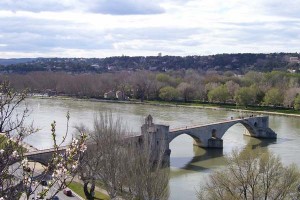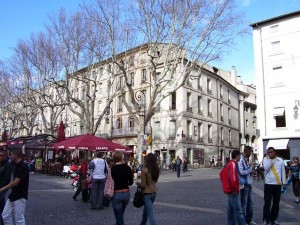THE RIVERS OF FRANCE-EXPLORING AVIGNON
THE RIVERS OF FRANCE
This is the third in a series of articles about a boat trip along the Rhone River
EXPLORING AVIGNON
By Charles N. Stevens
Photos by Dolores Seidman
Docked on the Rhone River, our ship rocks gently. Directly across from us are the gray stone walls that surround the old city of Avignon. As we will be here all day we’ll have a great opportunity to explore the old city.
We begin with a guide who leads us to a passageway through the thick city walls. Passing through the dank corridor gives us an idea of how massive these walls are, the barrier a necessity in bouncy castle for sale medieval times to keep invaders out of the city. Avignon is one of the relatively few European cities that have retained most of its city walls.
We pause briefly at the Chapel des Penitents Novi, the Black Penitents, the structure composed of dull gray stone, but with a spectacular contrasting sunburst smiling from its outer wall, a human face at its center.
Farther up the street we catch a glimpse of the golden statue of Mary perched high on the cathedral, gleaming brilliantly in the morning sun. Erected in the 19th century, it is the highest point in Avignon, its place a way of demonstrating the dominance of the church.
We soon get a view of the immense Papal Palace with its octagonal kitchen tower. As we gaze at its imposing walls we hear the humming roar of a street sweeper hosing down and scrubbing the ancient cobblestones of the streets, the stones glistening wet, the smell of damp dust in the air, a modern machine working in the shadow of medieval times.
The main purpose of our tour is to explore the Papal Palace (Palais des Papes). In 1309 Pope Clement V chose Avignon as his residence rather than Rome. From then until 1377 seven different popes reigned here. Avignon was just a small trading town on the Rhone until the pope actually bought it from the king. A whole industry then sprang up supplying the needs of the popes, their staff and court visitors. The fortress-like Papal Palace stands on a natural rock shelf and was assumed to be impregnable.
We walk carefully over the cobbled surface of the courtyard and enter the Chapel of Saint Jean. Just outside of it is a great hall where the pope received his guests. Traces of frescoes on the walls, damaged by bouncy castle for sale fire and time, hint at its former grandeur. Next is a large dining hall where the pope took his dinner on an elevated platform as befitting his position. The rest of the diners sat lower on both sides of the room, the staff serving food from the center. The high ceiling is constructed of chestnut wood to keep out spiders and insects. At one time it was painted sky blue with golden stars, now largely faded away.
Most interesting is the kitchen with its huge octagonal brick hood that rises sixty feet high, still showing the soot stains from roasting meat on great iron spits. I can imagine the tantalizing smell of the sizzling meat that rose up with the smoke.
Our tour takes us through the “Deer Room” with its old painting of a deer on the wall and a bedroom decorated with painted oak leaves on one wall and grape leaves on the other. We pass through Pope Clement’s study still showing its original ceiling then on to the crypts. Lions residing at the feet of the Popes’ statues represent the power of these men. After the seven popes who resided in Avignon served, two other popes also called it home. The problem was that there was also a pope in Rome at the time. Each vied for authority and eventually excommunicated each other.
The Papal Palace is too cold and stony for me, and the power that the popes once had plus the money they spent in constructing such a lavish palace bothers me.
In the afternoon Dolores and I walk into Avignon on our own. After negotiating many stairs and hiking uphill we arrive at a high terrace overlooking the whole city and beyond. Across the blue Rhone stands Fort St. Andre built in 1368. Farther away are the snow-capped mountains, the highest peak being Mont Ventoux, clouds resting on its shoulders. The town is dazzling in the sunlight, church spires dominating the skyline. The Rhone gleams as it curves by the city, and to our left stands the remains of the Pont de Avignon protruding out into the river, only four of its eighteen arches remaining. The bridge inspired the famous French song, “Sur le Pont d’Avignon.”
Later, in contrast, we enter the cold dark cathedral, ornate but old and stained. We look up at its vaulted stone ceiling and ahead at its simple altar, the colored glass windows dulled by the ages. I feel that I have just walked through somebody’s tomb.
We walk slowly downhill to the city square teeming with life. Church bells ring as crowds stream by, their voices a constant murmur. Bare plane trees cast spidery shadows on the stone buildings. People of all ages stroll by, talking, laughing and window shopping. Others sit in outdoor cafes sipping coffee or beer, sometimes smoking a cigarette. People seem to just like being together, enjoying their weekend with friends and family. A few rough looking girls wearing baggy clothes and jewelry piercing their ears and lips walk by smoking cigarettes. A man wearing a red suit and top hat plays a hurdy-gurdy as another man playing a trumpet tries to play along with him. A small crowd watches with rapt attention as a puppeteer unfolds a drama with precise movement of his puppets and the tones of his voice. On the other hand, a mime dressed and painted in white attracts not a single look. A few puffy clouds float in a deep blue sky.
Exhausted, images of Avignon swirling in our heads, we walk back to our small ship, our temporary home, and look forward to the next day’s adventure.

The Papal Palace with the golden statue of Mary towering above it.

The famous Pont d'Avignon now goes nowhere--a victim of time.

The people of Avignon doing what they like to do best.

We pause and watch the people stroll by in Avignon's market square.



